In the dynamic and ever-evolving cosmetics industry, precision, efficiency, and hygiene are paramount. From luxurious serums to vibrant lipsticks, every cosmetic product demands meticulous handling during its journey from formulation to packaging. This is where cosmetic filling machines play an indispensable role. Far more than just equipment, these sophisticated machines are the backbone of modern cosmetic production, ensuring products are accurately filled, beautifully presented, and safe for consumers.
This comprehensive guide delves deep into the fascinating world of cosmetic filling machines, exploring their various types, key functionalities, and critical considerations for manufacturers. Whether you’re a seasoned professional in the beauty industry or an aspiring entrepreneur, understanding these machines is crucial for optimizing your production line and elevating your brand.
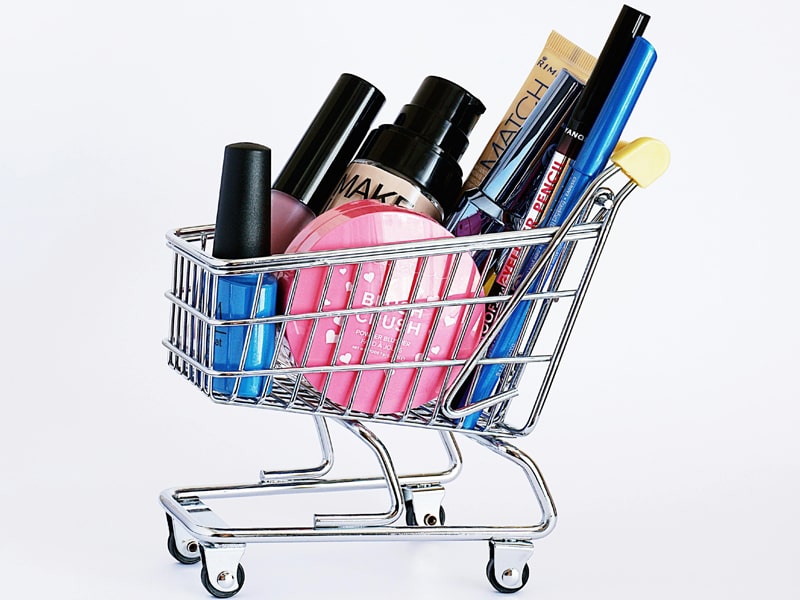
What Exactly is a Cosmetic Filling Machine?
At its core, a cosmetic filling machine is a specialized piece of industrial equipment designed to accurately and efficiently dispense cosmetic products into various containers, such as bottles, jars, tubes, pouches, and compacts. These machines are engineered to handle a wide range of product viscosities, from thin liquids like toners and perfumes to thick creams, gels, and even solid forms like powders.
The primary goal of a cosmetic filling machine is to ensure consistency in fill volume, minimize product waste, and maintain hygienic standards throughout the packaging process. This not only contributes to product quality but also significantly impacts production speed and cost-effectiveness.
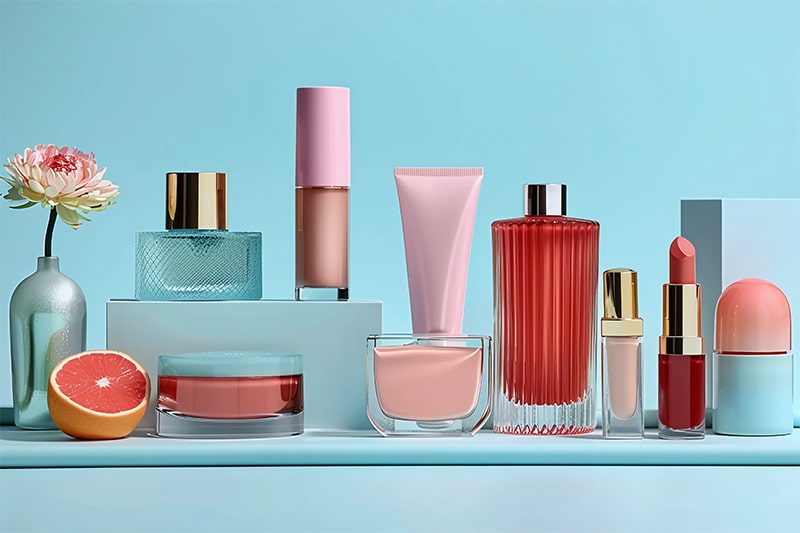
The Diverse Landscape of Cosmetic Filling Machines: A Classification by Filling Principle
The choice of a filling machine for cosmetics heavily depends on the product’s characteristics, container type, desired production speed, and budget. Here’s a breakdown of the most common types, categorized by their filling principles:
1. Piston Filling Machines: The Precision Masters for Viscous Products
Piston filling machines are renowned for their exceptional accuracy and versatility, making them ideal for a wide array of viscous and semi-viscous cosmetic products. Think of lotions, creams, gels, shampoos, conditioners, and even thick foundations.
How they work: These machines operate using a volumetric principle. A piston retracts to draw a precise volume of product into a cylinder, and then extends to dispense that exact volume into the container.
Key Advantages:
- High Accuracy: Excellent for consistent fill volumes, reducing product giveaway.
- Versatility: Can handle a wide range of viscosities, including products with small particulates.
- Less Foaming: Gentle filling action minimizes air incorporation, which is crucial for many cosmetic formulations.
- Durability: Robust construction for long-term use.
Considerations:
- Slower Speeds: Generally not as fast as some other filling methods for very high-volume production of thin liquids.
- Cleaning Complexity: Requires thorough cleaning, especially when switching between different products.
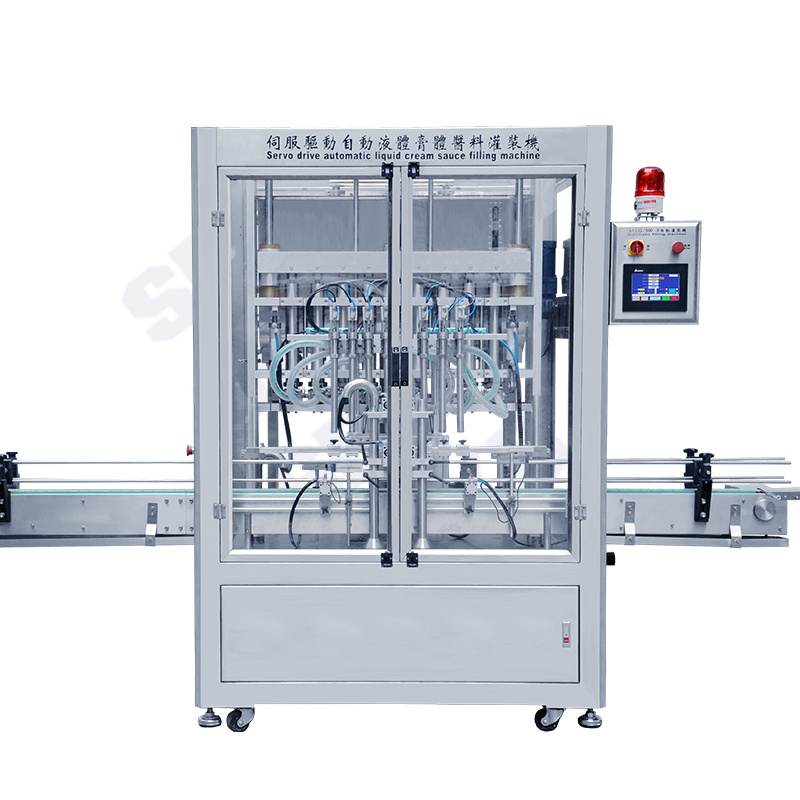 |
| XBGG series automatic multi-head servo drive piston filling machine |
2. Peristaltic Pump Filling Machines: The Gentle Touch for Sensitive Formulas
Peristaltic pump filling machines are a fantastic choice for sensitive, sterile, or low-viscosity cosmetic products. These often include serums, essential oils, fragrances, and certain medical-grade cosmetics.
How they work: These machines utilize a peristaltic pump, which works by squeezing a flexible tube through which the product flows. The product only comes into contact with the inside of the tubing, not the pump mechanism itself.
Key Advantages:
- Sterility: Ideal for sterile or aseptic filling as the product never touches mechanical parts.
- Gentle Handling: Minimizes shear and agitation, preserving the integrity of delicate formulations.
- Easy Cleaning & Changeover: Simply replace the tubing for quick and efficient product changeovers and cleaning.
- No Cross-Contamination: Eliminates the risk of cross-contamination between batches.
Considerations:
- Lower Speeds: Typically slower than piston or overflow fillers.
- Tubing Life: The flexible tubing has a finite lifespan and needs periodic replacement.
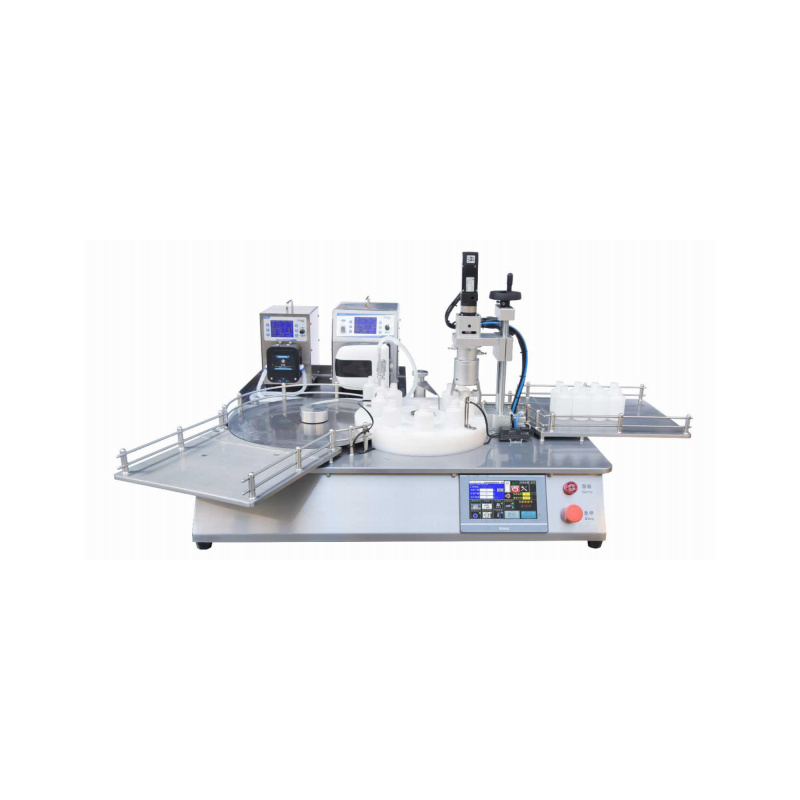 |
| Desktop bottle feeding peristaltic pump filling servo capping machine |
3. Gravity Filling Machines: The Economical Choice for Free-Flowing Liquids
Gravity filling machines are best suited for thin, free-flowing liquids with consistent viscosities. Examples in cosmetics include toners, micellar water, perfumes, and certain liquid soaps.
How they work: As the name suggests, these machines rely on gravity to fill containers. The product flows from an overhead tank through nozzles into the containers until a pre-set level is reached or the container is full.
Key Advantages:
- Cost-Effective: Generally less expensive than other filling technologies.
- Simple Operation: Relatively straightforward to operate and maintain.
- High Speeds: Can achieve high production rates for suitable products.
Considerations:
- Product Limitations: Not suitable for viscous products or those that tend to foam.
- Level Filling Only: Fills to a consistent level, not a precise volume, which might lead to slight variations in actual product volume if bottle inconsistencies exist.
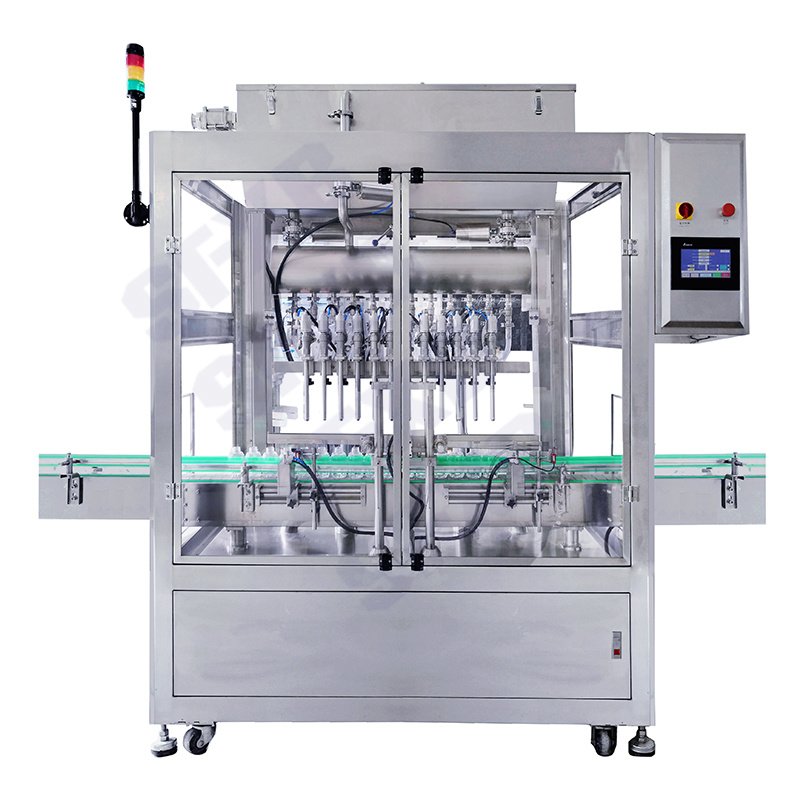 |
| XBZLS-8/12 head automatic head self-flow liquid filling machine |
4. Overflow Filling Machines: Aesthetic Consistency for Uneven Bottles
Similar to gravity fillers, overflow filling machines are also used for free-flowing to light-viscosity liquids. However, their unique advantage lies in their ability to fill containers to a visually consistent level, even if the internal volume of the containers varies slightly. This is particularly important for transparent or semi-transparent cosmetic bottles where consumers can see the fill level.
How they work: Product flows into the container until it reaches a specific level, at which point the excess product overflows back into a reservoir.
Key Advantages:
- Aesthetic Consistency: Ensures all bottles appear to be filled to the same height, enhancing visual appeal.
- Suitable for Clear Containers: Ideal for transparent bottles where fill level is visually critical.
- High Speeds: Efficient for high-volume production.
Considerations:
- Product Waste: Some product is recirculated, which may not be ideal for all formulations.
- Limited to Low Viscosity: Not suitable for thick or highly viscous products.
5. Pump Filling Machines (Rotary and Inline): Versatility Meets Efficiency
Pump filling machines encompass a broad category that utilizes various types of pumps (e.g., gear pumps, lobe pumps) to precisely dispense products. They can be found in both inline (linear) and rotary configurations. These machines are highly versatile and can handle a wide range of viscosities, from thin liquids to thick creams.
How they work: A pump accurately meters out a predetermined volume of product into each container.
Key Advantages:
- High Accuracy: Excellent volumetric accuracy.
- Wide Viscosity Range: Can handle almost any cosmetic product.
- High Speeds: Rotary pump fillers, in particular, can achieve very high production rates.
- Flexibility: Easily adaptable to different container sizes and product types.
Considerations:
- Cost: Can be more expensive than simpler filling methods.
- Maintenance: Requires regular maintenance of pump components.
6. Tube Filling Machines: Specialized for Squeezable Formulations
Dedicated tube filling machines are essential for products packaged in squeezable tubes, such as hand creams, toothpaste, lotions, and certain cleansers. These machines not only fill the tubes but also seal them (either with heat sealing for plastic/laminate tubes or crimping for metal tubes) and often code them.
Key Advantages:
- Integrated Filling & Sealing: A complete solution for tube packaging.
- High Speed Automation: Efficiently handles large volumes of tubes.
- Precision Filling: Ensures consistent fill in each tube.
Considerations:
- Single Container Type: Designed specifically for tubes, less versatile for other container types.
- Complexity: More intricate machinery due to the multiple functions it performs.
Key Features and Considerations When Choosing a Beauty & Cosmetics Filling Machine
Selecting the right beauty & cosmetics filling machine is a critical decision that impacts your production efficiency, product quality, and ultimately, your bottom line. Here are essential features and considerations to keep in mind:
1. Product Viscosity and Characteristics
The nature of your cosmetic product is the most significant factor.
- Low Viscosity: Perfumes, toners, micellar water – ideal for gravity or overflow fillers.
- Medium Viscosity: Lotions, liquid foundations, shampoos – suitable for piston or pump fillers.
- High Viscosity: Creams, gels, mascaras – best handled by piston or positive displacement pump fillers.
- Particulates: Products with exfoliants or glitters require specific nozzles and filling mechanisms to prevent clogging.
- Foaming Products: Certain products tend to foam during filling (e.g., some cleansers). Machines with bottom-up filling capabilities or specialized nozzles can mitigate this.
2. Container Type and Size
Consider the containers you’re using:
- Bottles & Jars: Varying shapes, sizes, and neck openings.
- Tubes: Plastic, laminate, or metal, requiring specific sealing mechanisms.
- Pouches: Flexible packaging requiring specialized filling and sealing.
- Compact/Palettes: For powder-based cosmetics, often requiring powder fillers.
The machine must be able to handle the dimensions and material of your chosen packaging. Quick changeover capabilities for different container sizes are also a huge advantage.
3. Production Speed and Automation Level
- Manual/Semi-Automatic: Suitable for small-scale production, startups, or R&D. Requires operator intervention for placing and removing containers.
- Automatic Inline Fillers: Ideal for medium to high production volumes. Containers move along a conveyor belt and are filled automatically.
- Automatic Rotary Fillers: Designed for very high-speed, continuous production. Containers are loaded onto a rotating turntable for filling and capping.
Your desired output per minute/hour will dictate the level of automation required.
4. Accuracy and Fill Consistency
Maintaining consistent fill volumes is crucial for cost control and customer satisfaction. Look for machines with high volumetric accuracy, especially for expensive cosmetic formulations. Overfilling leads to product giveaway, while underfilling can lead to customer complaints.
5. Hygiene and Cleanability (CIP/SIP)
Cosmetics are often sensitive to contamination. Clean-in-Place (CIP) and Sterilize-in-Place (SIP) capabilities are highly desirable, allowing the machine to be cleaned and sterilized without major disassembly. Stainless steel construction (especially food-grade 316L for product contact parts) is essential for hygiene and corrosion resistance. Easy disassembly for manual cleaning is also a plus.
6. Changeover Time and Flexibility
In a market driven by trends, cosmetic manufacturers often need to switch between different products and container sizes frequently. Machines with quick and tool-less changeover features significantly reduce downtime and increase operational flexibility.
7. Budget and Return on Investment (ROI)
Cosmetic filling machines represent a significant investment. Consider the initial purchase cost, ongoing maintenance, spare parts, and energy consumption. Evaluate the potential ROI based on increased production efficiency, reduced labor costs, and minimized product waste.
8. After-Sales Support and Maintenance
Reliable after-sales support, including technical assistance, spare parts availability, and training, is crucial for minimizing downtime and ensuring the longevity of your equipment.
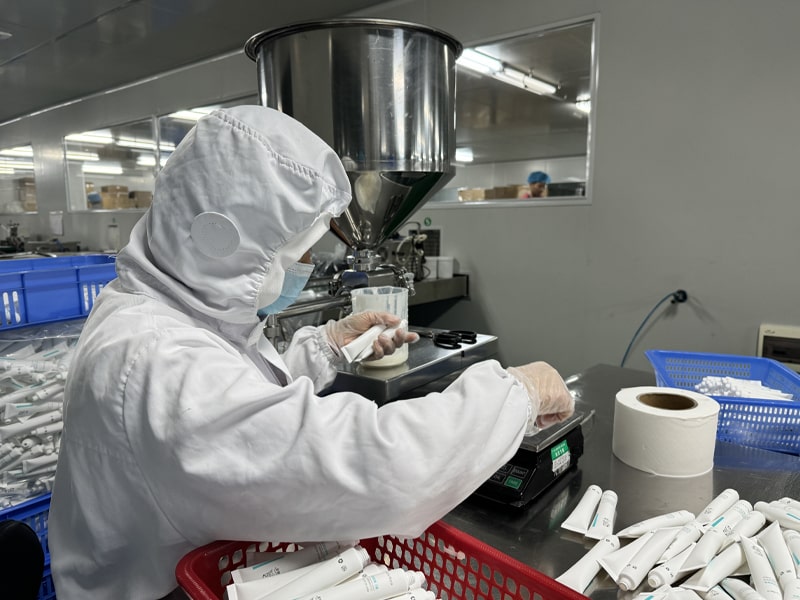
The Future of Cosmetic Filling: Innovation and Sustainability
The Beauty & Cosmetics Filling Machine sector is constantly evolving, driven by technological advancements and shifting consumer demands. Here are some key trends shaping the future:
- Increased Automation and Robotics: Further integration of robotics for handling, sorting, and packaging will enhance efficiency and reduce human error.
- Smart Machines and IoT: Predictive maintenance, remote monitoring, and data analytics will become standard, optimizing performance and preventing breakdowns.
- Sustainability Focus: Machines designed for minimal product waste, energy efficiency, and compatibility with eco-friendly packaging materials (e.g., refillable systems, recyclable plastics) are gaining prominence.
- Customization and Personalization: The rise of bespoke cosmetics will require more flexible filling machines capable of handling smaller batches and diverse formulations.
- Enhanced Hygiene Standards: Even more stringent hygiene protocols and sterile filling solutions will be adopted to meet evolving regulatory requirements and consumer expectations.
Conclusion: Investing in Precision for Beauty
In the competitive world of cosmetics, the right cosmetic filling machine is not just an expense; it’s a strategic investment. It’s an investment in precision, efficiency, hygiene, and ultimately, in the quality and integrity of your brand. By carefully considering your product, packaging, production goals, and budget, you can select a machine that seamlessly integrates into your manufacturing process, allowing you to consistently deliver exquisite cosmetic products to a discerning global market.
Choosing the right partner for your filling machine needs, a manufacturer with expertise and a strong reputation, is as important as the machine itself. SFXB(XueBapack) can provides invaluable guidance, custom solutions, and ongoing support to ensure your cosmetic production line operates at its peak performance. Embrace the power of advanced filling technology, and watch your cosmetic brand flourish.
Frequently Asked Questions (FAQ) About Cosmetic Filling Machines
1. What is a cosmetic filling machine?
A cosmetic filling machine is specialized industrial equipment designed to accurately and efficiently dispense cosmetic products into various containers like bottles, jars, tubes, and pouches, ensuring consistent fill volume, minimizing waste, and maintaining hygiene.
2. What types of cosmetic products can a filling machine handle?
Cosmetic filling machines can handle a wide range of product viscosities, from thin liquids like toners and perfumes to thick creams, gels, shampoos, foundations, and even semi-solid products for tubes.
3. Which type of filling machine is best for thick creams and lotions?
Piston filling machines are generally considered the best for thick creams, lotions, gels, and other viscous or semi-viscous cosmetic products due to their high accuracy and ability to handle varying viscosities.
4. How do peristaltic pump filling machines differ from other types?
Peristaltic pump filling machines are unique because the product only comes into contact with a flexible tube, not the pump mechanism itself. This makes them ideal for sterile, sensitive, or low-viscosity products, offering excellent hygiene and easy changeover.
5. Are gravity filling machines suitable for all cosmetic liquids?
No, gravity filling machines are best suited for thin, free-flowing liquids with consistent viscosities like toners and perfumes. They are not recommended for viscous products or those that tend to foam.
6. Why would a manufacturer choose an overflow filling machine?
A manufacturer would choose an overflow filling machine primarily for aesthetic consistency. It ensures that all containers appear to be filled to the same visual level, which is particularly important for transparent or semi-transparent cosmetic bottles.
7. What's the main advantage of an automatic rotary filling machine?
The main advantage of an automatic rotary filling machine is its capability for very high-speed, continuous production, making it suitable for manufacturers with large volume demands.
8. What does "CIP/SIP" mean in the context of cosmetic filling machines?
CIP (Clean-in-Place) and SIP (Sterilize-in-Place) are crucial features that allow the machine to be cleaned and sterilized without major disassembly, significantly improving hygiene and reducing downtime in cosmetic production.
9. What should I consider when choosing a filling machine for my cosmetic tubes?
When choosing a machine for cosmetic tubes, you'll need a dedicated tube filling machine. These machines not only fill but also seal (heat seal for plastic/laminate, crimp for metal) and often code the tubes, providing an integrated solution.
10. How important is after-sales support when buying a cosmetic filling machine?
After-sales support is extremely important. Reliable technical assistance, spare parts availability, and training from the manufacturer are crucial for minimizing downtime, ensuring the longevity of your cosmetic filling machine, and maximizing your investment.
| References: | |
| 1. | Process and machine for filling containers with cosmetic products ——Retrieved from:Google Patents |
| 2. | Cosmetic filling machines: Processing perfume, cream, lipgloss, mascara and more ——Retrieved from:Groninger |
| 3. | Good Practice Guide: Packaging, Labeling, & Warehousing Facilities ——Retrieved from:ispe.org |
| 4. | Cosmetics Europe (Official Website) |


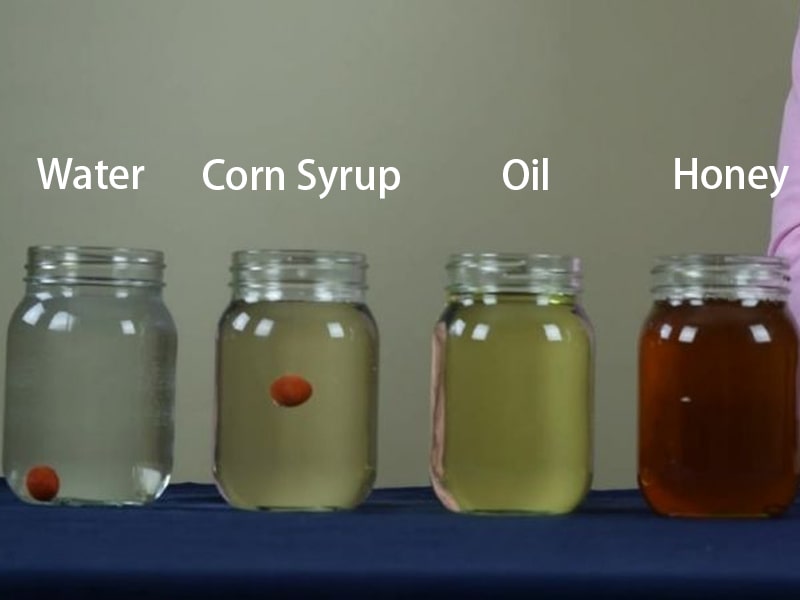

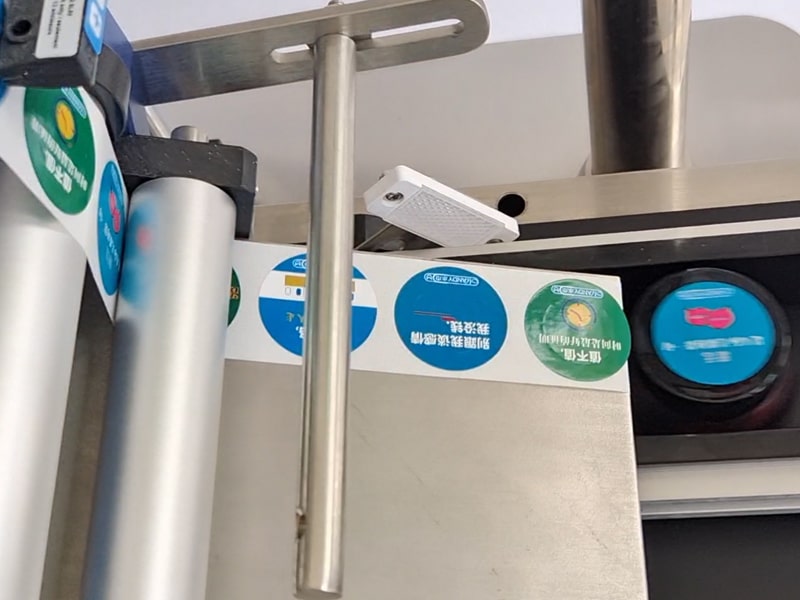

Comments